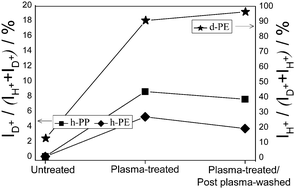A ToF-SIMS study of the deuterium—hydrogen exchange induced by ammonia plasma treatment of polyolefins†
Abstract

* Corresponding authors
a
Surface and Thin Film Analysis WG, BAM Federal Institute for Materials Research and Testing, Berlin, Germany
E-mail:
wolfgang.unger@bam.de
Fax: +49-30-8104-1823
Tel: +49-30-8104-1827
b Division VI.5 Polymer Surfaces, BAM Federal Institute for Materials Research and Testing, Berlin, Germany

 Please wait while we load your content...
Something went wrong. Try again?
Please wait while we load your content...
Something went wrong. Try again?
H. Min, S. Wettmarshausen, J. F. Friedrich and W. E. S. Unger, J. Anal. At. Spectrom., 2011, 26, 1157 DOI: 10.1039/C1JA10043B
To request permission to reproduce material from this article, please go to the Copyright Clearance Center request page.
If you are an author contributing to an RSC publication, you do not need to request permission provided correct acknowledgement is given.
If you are the author of this article, you do not need to request permission to reproduce figures and diagrams provided correct acknowledgement is given. If you want to reproduce the whole article in a third-party publication (excluding your thesis/dissertation for which permission is not required) please go to the Copyright Clearance Center request page.
Read more about how to correctly acknowledge RSC content.
 Fetching data from CrossRef.
Fetching data from CrossRef.
This may take some time to load.
Loading related content
